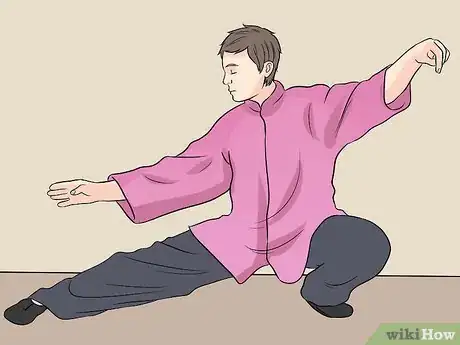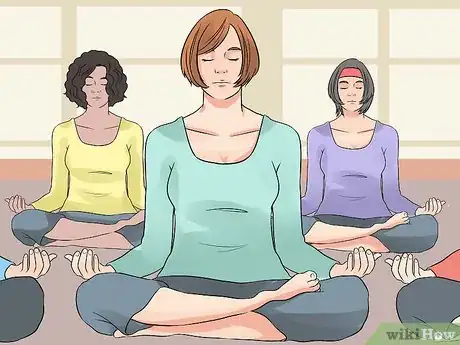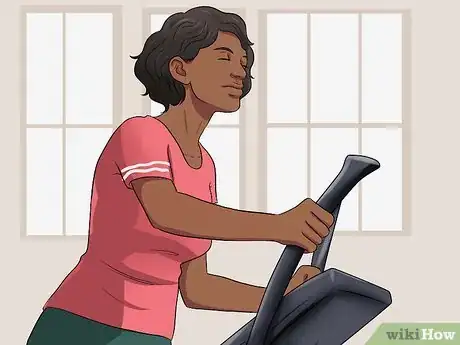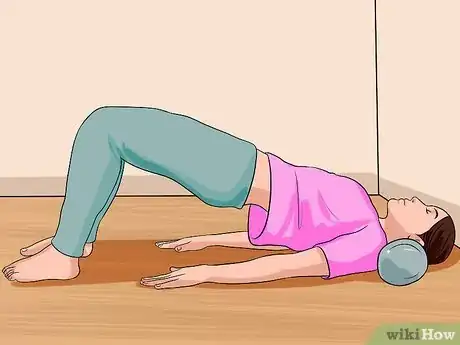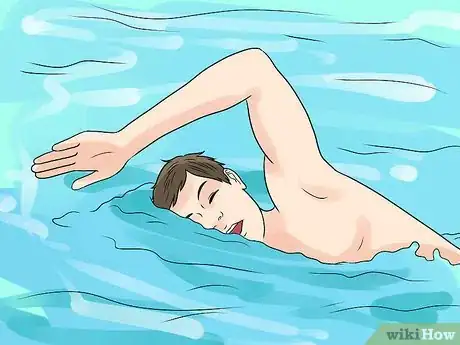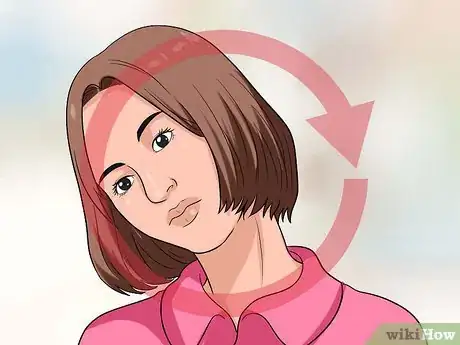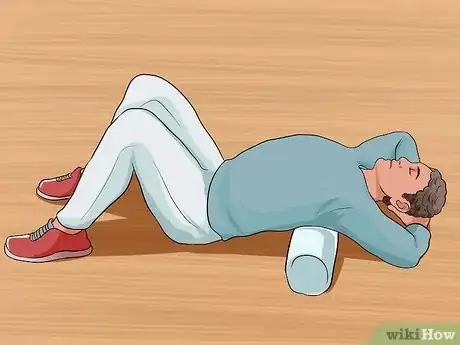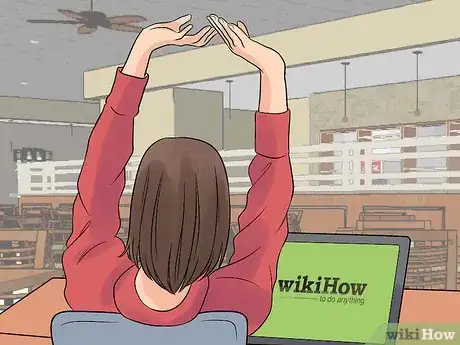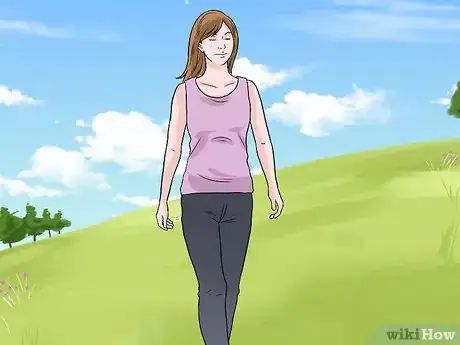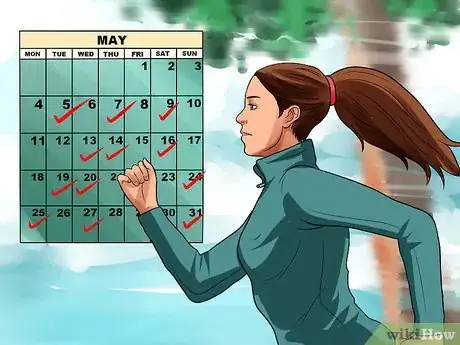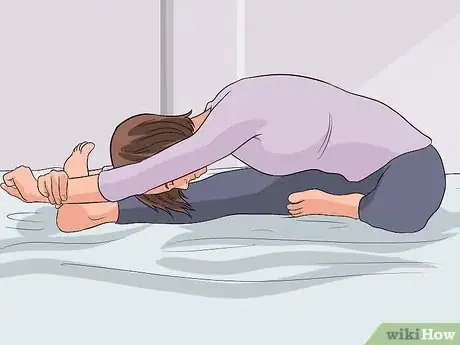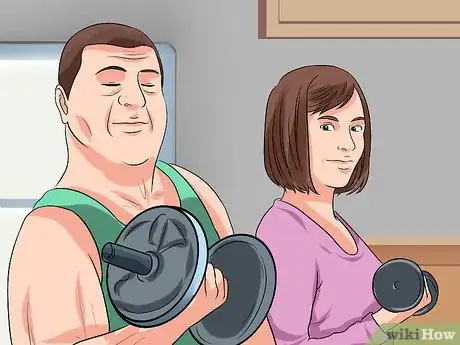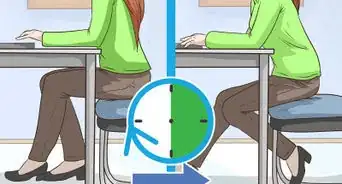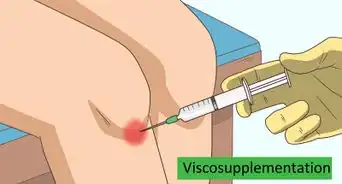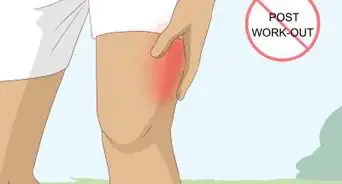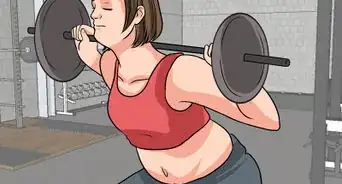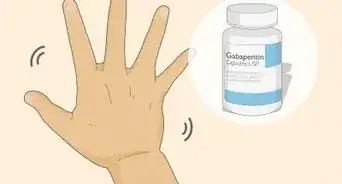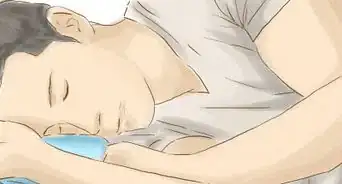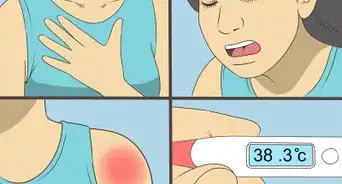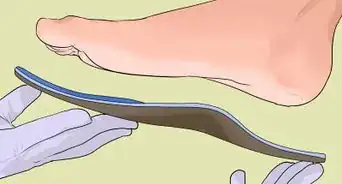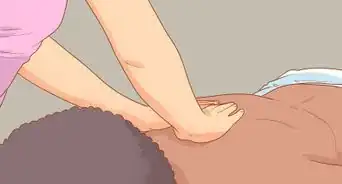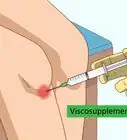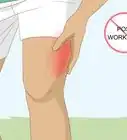This article was co-authored by Julian Arana, M.S.eD., NCSF-CPT. Julian Arana is a Personal Trainer and the Founder of B-Fit Training Studios, a personal training and wellness set of studios based in Miami, Florida. Julian has over 12 years of personal training and coaching experience. He is a certified personal trainer (CPT) by the National Council on Strength and Fitness (NCSF). He has a BS in Exercise Physiology from Florida International University and an MS in Exercise Physiology specializing in strength and conditioning from the University of Miami.
There are 7 references cited in this article, which can be found at the bottom of the page.
This article has been viewed 28,712 times.
If you have tight joints, you may be looking for exercises that can help loosen your joints and keep your body more flexible. Stiff joints can be difficult and even painful to live with. However, regular exercise can help keep your joints loose, limber and your body feeling more flexible overall. Some exercises - both aerobic and stretching exercises - can help loosen your joints. By doing a variety of these exercises most days of the week, you can help prevent any pain, stiffness or tightness in your muscles and joints.
Things You Should Know
- Try getting involved with an activity like tai chi, yoga, swimming, or pilates to help keep your joints limber.
- At home, try stretch regularly, strength training, and doing range of motion exercises like head and neck rolls, shoulder shrugs, and side bends.
- Massage and foam rolling are really soothing if you're suffering from joint stiffness.
- Remember to warm up and cool down each time you exercise to prevent stiffness in the first place.
Steps
Doing Aerobic Exercises to Loosen Joints
-
1Try tai chi. One of the best exercises that you can do to loosen your joints is tai chi. In fact, one of the sought after benefits of tai chi is the ability to keep joints loose and flexible.[1]
- Tai chi is an ancient Chinese exercise that was designed to help calm and focus your mind while reducing stress and loosening stiff joints.
- If you want to loosen your joints, try starting with tai chi. It's a great exercise as its appropriate for any fitness or skill level. You'll be guided through a series of fluid movements while be instructed to calm and focus your mind.
- Look for a local tai chi class that you can attend. Or you can look online for tai chi videos or consider purchasing a DVD so that you can do tai chi in the comfort of your own home.
-
2Go to a yoga class. Similar to tai chi, yoga is another great exercise to help loosen up your joints. Although a little more difficult than tai chi, it's still a great exercise that can be tailored to any fitness level.
- Studies have shown that yoga has a variety of health benefits. In particular, yoga can help relieve joint pain and stiffness and improve range of motion and flexibility.
- Not all yoga classes will be useful to help loosen your joints. Look for restorative yoga, yoga for beginners or yoga for arthritis or pain relief. These classes will be geared toward improving flexibility and range of motion.
- If you belong to a gym, see if they offer yoga classes. If not, try looking for a local yoga studio to take a class. You can also find a variety of DVD's and online videos that you can use to do yoga at home.
Advertisement -
3Hop on the elliptical. To help get your heart rate up and burn some calories while loosening up your joints, consider using the elliptical. It's a great machine that's easy on the joints and helps with your flexibility.[2]
- The elliptical machine is a great idea for those who want to get in a good cardio workout while loosening their joints. You'll work up more of a sweat compared to doing yoga or tai chi.
- The elliptical is great because it allows your joints to move through a full range of motion without the rough impact. The machine pulls your body through fluid motions.
- Try to use the handles of the elliptical as well. You'll work your body harder, but also keep your upper body and joints moving which will help loosen them up.
- Do at least 20 minutes of the elliptical (or another form of cardiovascular activity). Don't forget to stretch afterward!
-
4Try pilates. Similar to yoga, pilates is a strength training class that also helps loosen and strengthen your joints. This is a great exercise to do if you want to build muscle mass or strength in addition to loosening stiff joints.[3]
- Pilates is a class that uses a floor mat or machine to do exercises. It's focus is to help improve balance and flexibility by focusing on joint mobility and stability.
- When you work through each pilates pose, you will be focusing on working one particular joint or group of muscles. This allows you to move through each joint and work on loosening it up and improving flexibility.
- Look for a pilates class at your gym or a local studio in your area. Some pilates exercises can be done at home so following online videos or DVDs at home is also a great idea.
-
5Go for a swim. Swimming, water aerobics or any type of water sport or exercise can help you loosen your joints. The buoyancy provided by the water helps make exercise easier while allowing you to relieve joint stiffness.[4]
- When you're in water, it can help you feel 50% lighter (or more) than you would on land or out of the water. This lightness allows you to perform different exercises and move your body in ways that wouldn't be easy or possible otherwise.
- One of the best parts about swimming or water aerobics is that these exercises require the use of multiple joint groups - both upper and lower body. As you warm up and move through exercises, you'll loosen up most if not all of your joints.
- Look for a water aerobics class near you. If you can't find one, consider swimming laps at your local pool, gym or recreation center.
- Other exercises that you can do in pool include cycling in a donut, walking back and forth, walking sideways, and walking backward. Some water-based strength training exercises include squats, side leg raises, step-ups, and balancing on one leg. If you are feeling that these exercises are too easy, then you may want to add water weights to your ankles.
Keeping Your Joints Loose
-
1Do range of motion exercises daily. Although there are some specific exercises that you can do that loosen joints and decrease stiffness, one of the best things you can do are range of motion exercises.[5]
- Range of motion exercises are not aerobic activities or strength training. The goal of these exercises is specifically to loosen joints and maintain or improve the range of motion you have at each of your joints.
- If you want to loosen your joints, regardless of the reason, doing range of motion exercises is essential. They're easy enough to do on a daily basis and can loosen joints on the spot.
- Range of motion exercises can be done at home. Try the following: neck or head rolls, shoulder shrugs, shoulder rolls, side bends, trunk rotation or hip rolls.
-
2Try self-massage and foam rolling. If you need to focus on loosening your joints, you might have joint stiffness. In addition to loosening your joints with exercise, self-massage and foam rolling can also keep your joints loose.[6]
- Foam rollers and massages aren't just for athletes. Studies have shown that these practices if done on a weekly basis can help reduce joint pain and stiffness by about half.
- Foam rolling and self-massage specifically targets the fascia around your muscles and joints. When irritated (which happens more frequently as you age), it makes joints feel stiff, tight and sore.
- Purchase a foam roller to keep at home to use on a regular basis. Spend a few minutes after you exercise or do range of motion exercises to roll over specific joints or areas that feel tight and you want to be looser.
-
3Stretch regularly. Stretching on a regular basis is an easy way to keep joints loose as well. However, you need to be careful with what stretches you do and how you perform them.
- Talk to your doctor or physical therapist about the best types of stretches for your body. Also get specific guidance and instruction on how to stretch safely.
- Best upper body stretches include: lying abdominal stretch, tricep stretch, seated forward bend and mid back stretch.
- For your lower body, try: hip flexor stretch, hamstring stretch, butterfly stretch, and seated hip stretch.
- Note that many stretching exercises can also be considered range of motion exercises and complete two types of exercises in one.
-
4Try a variety of exercises each week. There are many different types of exercises that you can do to help loosen your joints. Try to include a variety of these exercises each week, instead of focusing on just a single activity.
- Studies have shown that if you continuously participate in only one or two types of exercises each week, you're more at risk for overuse injuries. This can weaken your muscles around the joint and cause your joint to take on more impact. Overtime, this can lead to joint stiffness, pain and even damage.
- To prevent this from happening, aim to include a few different types of exercises each week. Alternate between the intensity of the exercise and which joints or muscle groups are primarily involved.
- For example, if you normally go for a walk Monday and Wednesday morning, try out a water aerobics class on Tuesday and use the Elliptical on Friday.
Preventing Stiff Joints and Muscles
-
1Stay consistent with activity. If your joints are tight, exercising may be something that can be hard to get started with. However, the more you exercise and the more consistent you are, the looser your joints will be.
- Studies have shown that those who exercised at least 2 times per week had a significant decline in pain and stiffness in their joints.[7]
- An occasional exercise session will loosen your joints and relieve stiffness. However, if you don't keep up with this routine, your joints will regress back to being stiff.
- To avoid this, exercise consistently and regularly. This means you'll need to exercise at least 3-4 times per week or more often. You'll notice that the more consistent you are, the less pain and stiffness you'll feel with time.
-
2Include a warm-up and cool-down with exercise. If you want to loosen your joints with exercise, it's important to put in some extra time before and after a workout to do just that.[8]
- Exercise will loosen your joints. However, you need to give your body time to loosen up through a warm-up. Spend about 5-10 minutes getting your body warmed up.
- A warm-up will help increase blood flow to your joints and muscles. This helps them get physically warm and increases the oxygen and nutrient rich blood that's being delivered.
- Spend your warm-up doing a few minutes of a slower, lower intensity activity. You could walk on the treadmill, cycle slowly or use the elliptical without resistance.
- Keep joints from getting stiff after your exercise routine by stretching and doing range of motions exercises as a cool down.
-
3Push through light to mild aches and pains. If you have arthritis or another degenerative joint condition, it's likely that you have the occasional ache or pain in your joints. Most times, it's actually beneficial to push through those pains.
- Health professionals note that it's normal and to be expected to have some initial pain, stiffness or tightness in your joints when you first start moving. However, if you continue with movement, stretching or range of motion exercises, the pain should subside.[9]
- Continued movement helps lubricate your joint which can help it loosen it up and feel more flexible.
- If the pain is sharp, doesn't go away or gets worse with movement, discontinue exercise. You'll most likely need to talk to your doctor about this type of pain.
- Taking over-the-counter NSAIDS as needed may be in order to help you get through your workout. However, be careful with these medications, as they can cause gastrointestinal distress and gastric ulcers.
-
4Do strength training. Although cardiovascular exercise and stretching are great to loosen joints, strength training is equally important to prevent joint stiffness.
- Joints become stiff when the muscles and ligaments around them are tight and stiff. This can occur more frequently if those same muscles and ligaments are weak.
- Strength training exercises not only build muscle, but also are key for building muscle strength and tone of the ligaments and muscle groups around your joints.
- In addition to your cardio activities and stretching, include 1-2 days of strength training. Always warm-up before lifting weights as well.
Expert Q&A
-
QuestionDoes exercise reduce stiffness?
 Julian Arana, M.S.eD., NCSF-CPTJulian Arana is a Personal Trainer and the Founder of B-Fit Training Studios, a personal training and wellness set of studios based in Miami, Florida. Julian has over 12 years of personal training and coaching experience. He is a certified personal trainer (CPT) by the National Council on Strength and Fitness (NCSF). He has a BS in Exercise Physiology from Florida International University and an MS in Exercise Physiology specializing in strength and conditioning from the University of Miami.
Julian Arana, M.S.eD., NCSF-CPTJulian Arana is a Personal Trainer and the Founder of B-Fit Training Studios, a personal training and wellness set of studios based in Miami, Florida. Julian has over 12 years of personal training and coaching experience. He is a certified personal trainer (CPT) by the National Council on Strength and Fitness (NCSF). He has a BS in Exercise Physiology from Florida International University and an MS in Exercise Physiology specializing in strength and conditioning from the University of Miami.
Certified Personal Trainer Generally speaking, yes. It certainly depends on what kind of exercise you're engaging in, but if you're building up your strength and flexibility, you're less likely to experience stiffness.
Generally speaking, yes. It certainly depends on what kind of exercise you're engaging in, but if you're building up your strength and flexibility, you're less likely to experience stiffness.
References
- ↑ http://www.arthritis.org/living-with-arthritis/exercise/workouts/other-activities/tai-chi-arthritis.php
- ↑ http://www.arthritis.org/living-with-arthritis/exercise/workouts/other-activities/workouts-for-arthritis.php
- ↑ http://www.arthritis.org/living-with-arthritis/exercise/workouts/other-activities/workouts-for-arthritis.php
- ↑ http://www.arthritis.org/living-with-arthritis/exercise/workouts/other-activities/workouts-for-arthritis.php
- ↑ Julian Arana, M.S.eD., NCSF-CPT. Certified Personal Trainer. Expert Interview. 19 March 2020.
- ↑ Julian Arana, M.S.eD., NCSF-CPT. Certified Personal Trainer. Expert Interview. 19 March 2020.
- ↑ http://www.arthritis.org/living-with-arthritis/exercise/how-to/starting-exercise-program.php
- ↑ https://www.heart.org/en/healthy-living/fitness/fitness-basics/warm-up-cool-down
- ↑ http://www.arthritis.org/living-with-arthritis/exercise/how-to/exercise-pain.php
- ↑ Julian Arana, M.S.eD., NCSF-CPT. Certified Personal Trainer. Expert Interview. 19 March 2020.
